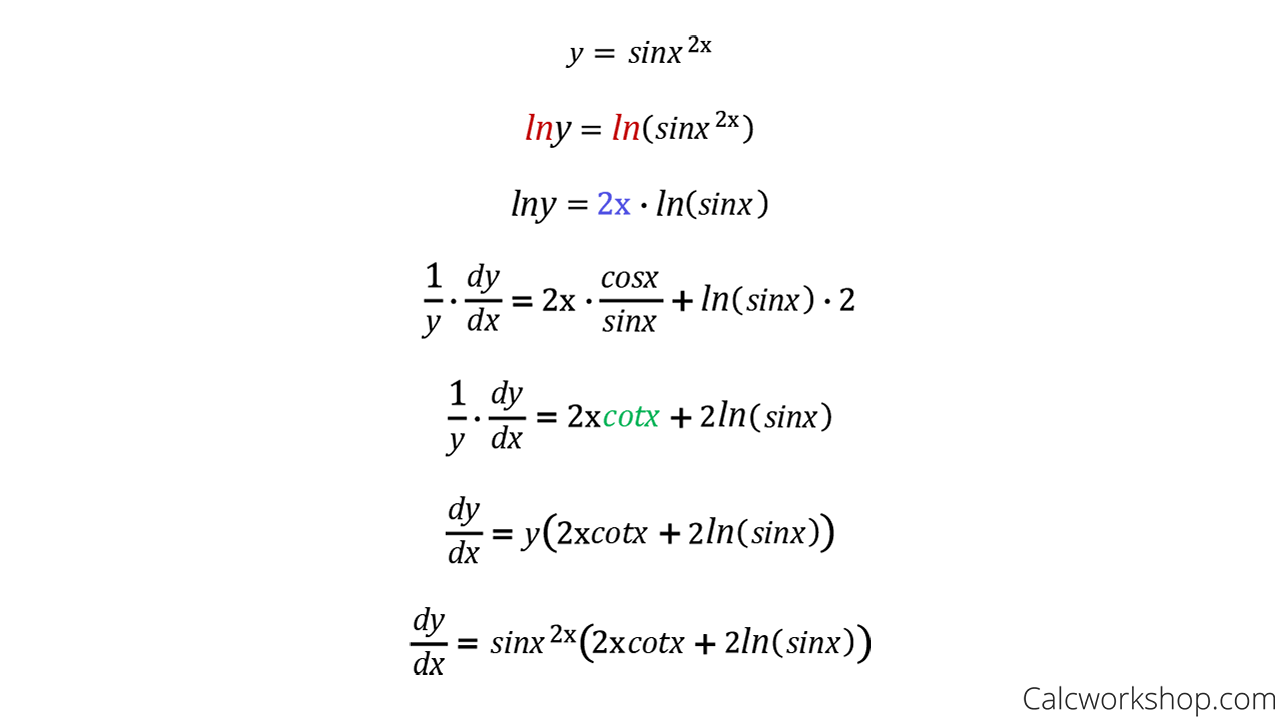Again remember that the derivative of lnx 1x. Find the derivative of logarithmic functions.

Answered Use Logarithmic Differentiation To Find Bartleby
Use logarithmic differentiation to determine the derivative of a function.

Use logarithmic differentiation to find the derivative of the function. Solve the resulting equation for y 4. Dydxlog_beuu where u is the derivative of u. First assign the function to y then take the natural logarithm of both sides of the equation.
The digamma function and polygamma functions are the logarithmic derivatives of the gamma function. Take natural logarithms of both sides of an equation yfx and use the Laws of Logarithms to simplify. Y sqrtfracx - 2x6 4 By signing up youll get.
Use logarithmic differentiation to find the derivative of the function. Logarithmic differentiation typically requires that you take the natural logarithm or ln of both sides of the equations. In these cases you can use logarithmic differentiation in order to find the derivative.
Log b e is a constant. The logarithmic derivative can be any function that you find the log for and take the derivative. The logarithmic derivative of the sine function is the cotangent function.
By the proper usage of properties of logarithms and chain rule finding the derivatives become. Logarithmic functions differentiation intro. There are cases in which differentiating the logarithm of a given function is simpler as compared to differentiating the function itself.
Find the derivative of exponential functions. To derive the function xx use the method of logarithmic differentiation. Okay this is as far as we can simply the problem using logarithmic differentiation.
The logarithm function is a very specific function fx logbxthe inverse of the exponential function. Y x 8cosx. Lny lnx8cosx.
So far we have learned how to differentiate a variety of functions including trigonometric inverse and implicit functions. Derivative of log₄x²x using the chain rule. Now all you have to do is take the derivative of the right side.
Differentiating Logarithmic Functions with Bases other than e. Y sin9xnx y In sin9x x9cos9x - Inx - sin 9x Inx X Get more help from Chegg Solve it with our calculus problem solver and calculator. Steps in Logarithmic Differentiation 1.
Logarithmic differentiation is a method used to differentiate functions by employing the logarithmic derivative of a function. This is the currently selected item. More importantly however is the fact that logarithm differentiation allows us to differentiate functions that are in the form of one function raised to another function ie.
Y log b u is a logarithm with base b then we can obtain the derivative of the logarithm function with base b using. To derive the function xx use the method of logarithmic differentiation. U fx is a function of x and.
In this section we will discuss logarithmic differentiation. Logarithmic differentiation is a method to find the derivatives of some complicated functions using logarithms. Replace y with original equation.
Use logarithmic differentiation to find the derivative of the function. The differentiation of log is only under the base e e e but we can differentiate under other bases too. This allows you to algebraically manipulate and simplify the equation so that it can be differentiated more easily.
In this section we explore derivatives of. Differentiate implicitly with respect to x 3. Differentiating logarithmic functions using log properties.
If a function has two or more independent factors and needs to be differentiated we can apply the logarithmic rule of differentiation. Y x8 cosx y X Get more help from Chegg Solve it with our calculus problem solver and calculator. Use logarithmic differentiation to find the derivative of the function.
First assign the function to y then take the natural logarithm of both sides of the equation yxx. Y cos x x. I will take the derivative of 2 ln x3 2 and 4 ln x5 4 separately so you can see what is going on.
How can I find the. Use logarithmic differentiation to find the derivative of the function. Logarithmic differentiation gives an alternative method for differentiating products and quotients sometimes easier than using product and quotient rule.
Find the derivative using logarithmic differentiation method ddxxx. It is particularly useful for functions where a variable is raised to a variable power and to differentiate the logarithm of a function rather than the function itself. Derivatives of logarithmic functions are mainly based on the chain ruleHowever we can generalize it for any differentiable function with a logarithmic function.
Use logarithmic differentiation to find the derivative of the function. Start out by taking the natural logarithm of both sides to get. I am assuming that the function is.